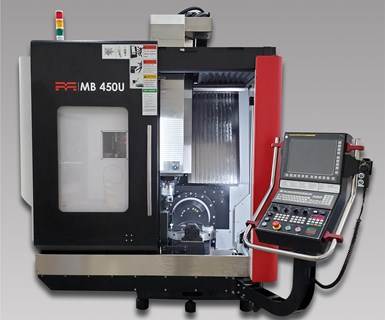Methods MB 450U Performs Simultaneous Five-Axis Machining
The MB 450U bridge-type machining center from Methods Machine Tools performs simultaneous five-axis work thanks to its FANUC control.
Share





The MB 450U bridge-type machining center from Methods Machine Tools performs simultaneous five-axis work thanks to its FANUC control. The FANUC 31i-MB5 has a 15" color display and includes a 2-GB data server, Manual Guide I, AICC II 600-block look ahead, 1 MB of NC memory and 0.4 ms block processing time. The CNC also offers collision detection with a 3D interference check and Fast Package III with tool centerpoint control.
The 15,000-rpm Big Plus, 40-taper spindle is equipped with air-oil lubrication and a spindle chiller for longevity. The 15-hp hollow-shaft spindle motor is equipped with 1,000-psi (70-bar) coolant-through spindle prep and couple. The dual swing-arm-type automatic toolchanger can hold 48 tools. Travels measure 15.7" (400 mm) on the X axis and 13.8" (350 mm) on the Y and Z axes. The B axis has -50 to +110-degree tilting capability, while the rotary C axis has a 360-degree rotation angle.
For machining stability, the 13,250-lb MB 450U has a bridge-type construction with thermal compensation. The machine is equipped with 1.771" (45 mm) linear roller guide ways in the X and Y axes and 1.377" (35 mm) ways in the Z axis. Heidenhain linear scales in the X, Y and Z axes and Heidenhain rotary scales in the B and C axes deliver precise motion. Kinematic calibration features a spindle probe with a table centerpoint calibration ball and kinematic software. A Laser Tool Measurement System detects tool wear, damage and breakage, reducing non-productive time and enabling automated operation.
Related Content
-
Quick-Change Tool Heads Reduce Setup on Swiss-Type Turning Centers
This new quick-change tooling system enables shops to get more production from their Swiss turning centers through reduced tool setup time and matches the performance of a solid tool.
-
How to Determine the Currently Active Work Offset Number
Determining the currently active work offset number is practical when the program zero point is changing between workpieces in a production run.
-
Lean Approach to Automated Machine Tending Delivers Quicker Paths to Success
Almost any shop can automate at least some of its production, even in low-volume, high-mix applications. The key to getting started is finding the simplest solutions that fit your requirements. It helps to work with an automation partner that understands your needs.





















